Burdock 2
gas-tronomy
Within the SubStack Universe are gastronomical artists whose culinary delights require considerable forethought, organization, and skillful execution. You can find some of them here:
What comes out of the kitchen of weedom is no such art. Usually we get ‘er done on the fly, combining what we grab from the gardens, our weeds, and whatever is in the house at the time. Relying on a good sense of smell to determine which flavors go well together usually serves to prevent severe disasters, worthy only of composting.
What happens when the ‘health food’ tastes so good that we could binge our way to massive flatulence? Perhaps flotation ability or jet propulsion would be achieved through the production of hot gasses.
Burdock roots and cucumbers can produce additive propulsive potential, so we were inspired to flirt with biological warfare by combining these two items with some peppers and onions (which we have in vast excess). Last minute pangs of compassion for our neighbors caused us to leave the available eggs and cruciferous vegetables out of this mixture. (There are enough skunks in the area already.)
Those who read last week’s post remember the early harvested burdock root, and today, you can see what we did with it. Below it is shown after having been scrubbed and scraped with a knife. In order to keep it from immediately turning brown, some lime juice was directly applied. Any acidic rinse will do, including lemon juice or dilute vinegar of your preferred flavor.
The burdock was sliced thinly, with more lime juice sprinkled on it, then tossed into a cast iron skillet with a teaspoonful of bacon fat. The left/bottom view shows desired doneness.
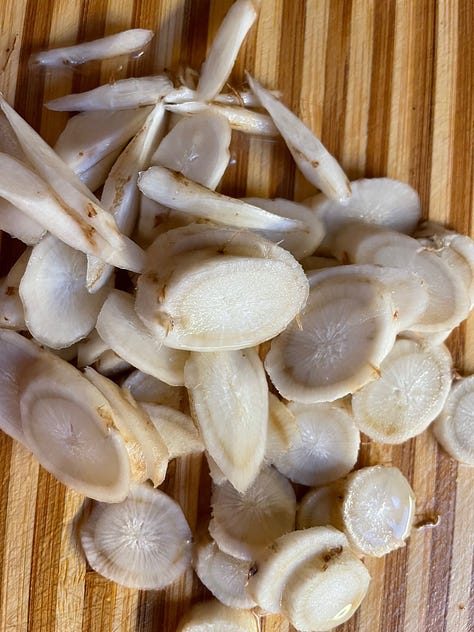
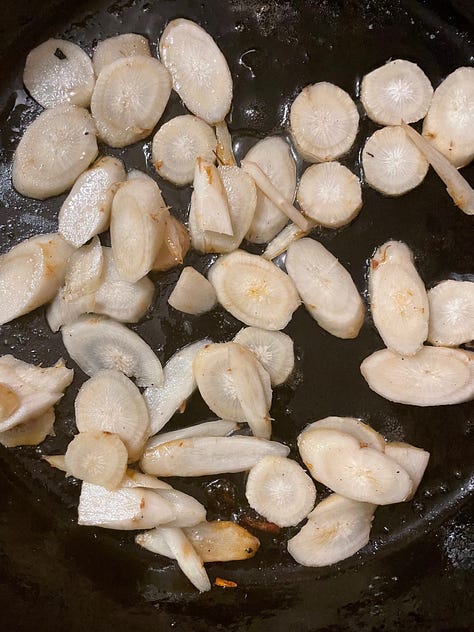
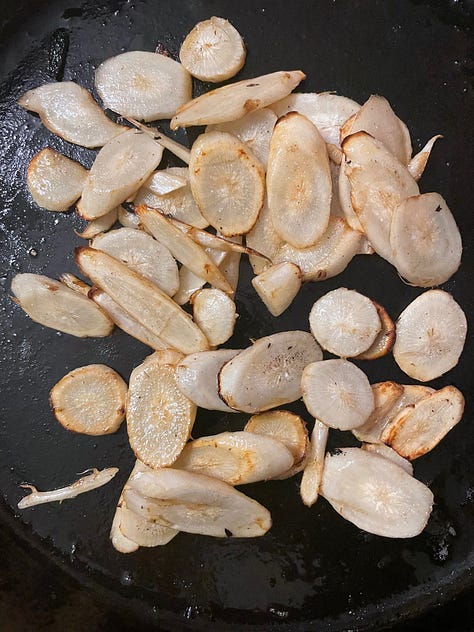
Peppers, a whole onion, and cucumber were given the same treatment in that same skillet, and then combined with the burdock. Cilantro, which is now in season was added for good measure. A sesame/soy/ginger sauce was drizzled on it, and mixed in at the last minute. You can buy this kind of sauce, or mix it yourself using arrowroot as a starch to thicken it if you desire.
This concoction was served along side some basmati rice plus cilantro, and roasted chicken, and our taste buds were well pleased.
The burdock root is tremendously nutty sweet, and many people will find it very easy to eat large amounts. We consumed perhaps 60 grams per person, and even combined with similar cucumber quantity, we did not experience extreme sound and fury. However if you decide to start with triple that amount, choose your next day’s theater of action carefully.
We have high incentive to dig more burdock, for both the flavor and the health benefits, and hope that you are able to procure some for yourselves. Check out a good Asian food store if you aren’t able to dig your own.
You might wonder what’s the big incentive to risk a bit of gas for the sweetness of Burdock root? Is it that special? Yes it is, like Chicory Plus. Those of you who read that post might remember that chicory is a strong commercial source of inulin which is used for all sorts of food preparation and as an additive in all sorts of processed food, as well as for its nutraceutical benefits. Burdock root is bigger and has more. It’s a better source for human scale harvesters.
The world of medicine is all entranced with gut health and its extensive effects on all other bodily systems, including the central nervous system. Your microbial environment in the gut has huge influence over how you feel, your mood, alertness, and your resistance to disease. The wonders of the Bifidobacteria species, (B. infantis and B. longum) are extolled as helpful in changing the gut environment, lowering the pH, and reducing the populations of unwanted or harmful bacteria associated with food poisoning and toxin production. The Bifidobacteria in particular are able to digest inulin, which is made up of linear chains, (called fructans) of various lengths, with beta (2—>1) linked fructose molecules that our own digestive enzymes (alpha glycosidases) can’t break down. You were just waiting for some chemistry, right? The various size polymer chains of inulin are not able to be absorbed from our digestive tracts, so to some extent they comprise a zero-calorie, carbohydrate source of sweet food flavor. If you dig your own burdock, this could become negative-calorie food :-D . While the Bifidobacteria and Lactobacillus species can digest the fructans, Clostridium perfringens, E. Coli and Listeria monocytogenes and other bacteria cannot. Therefore the presence of inulin helps to encourage a more salutary bacterial population. Results of a human trial suggest that adding fructans to the diet can speed recovery from diarrheal illness caused by overgrowth of bacterial pathogens.
Fatty acids such as acetate, butyrate and proprionate produced by bacterial fermentation of inulin decrease the pH of intestinal contents, and increase bacterial enzyme activity. Inulin also seems to increase the absorption of calcium in healthy human subjects. It affects the plasma level of glucagon-like peptide 1 and production of glucagon-like peptide 2, and decreases levels of ghrelin (also called the hunger hormone) that influence appetite and growth hormone production. These latter effects on glucagon-like peptides may partially explain the results of studies that showed significant reduction of 4 glycemic indicators in various patient groups who received inulin supplementation in the diet. This suggests that inulin may provide real benefits to those with prediabetes or type 2 diabetes.
The intestinal wall has a large role in the body’s immune functions. Inulin plays a part in modulating the immunological activity of gut associated lymphoid tissues (GALT), which serve as an interface between the vast populations of flora in the gut, and the rest of the body. The job of GALT is to distinguish harmless agents from disease causing agents, while preventing hypersensitivity reactions to innocuous, resident flora and harmless antigens within the body. Gut associated lymphoid tissue includes organized areas such as Peyer’s patches, mesenteric lymph nodes, the appendix, and diffuse, isolated lymph nodes which are involved in processing and presenting antigens. Directly below the intestinal epithelium are M cells, B cells, T cells, and dendritic cells. These systems directly engage with gut bacteria and affect the composition of their populations by secreting antimicrobial peptides and immunoglobulins. In turn, the gut bacteria influence the GALT systems by various mechanisms, including modulating the proportions of specific T cell populations. Some of the means by which inulin influences the immune function is by influencing the populations of gut bacteria, favoring some species and decreasing growth of other species. The short chain fatty acids which are produced from the inulins by gut bacteria also have direct activity on receptors of the immune cells within the GALT. These fatty acids also favor mucin production within the lower intestinal lumen. In general, the growth and survival of pathogens is reduced, and inflammatory activity is reduced, and this favors integrity of the intestinal epithelium.
That’s just an overview of what the inulin of burdock can do for your digestive tract, and a bit of how it could address type 2 diabetes and obesity.
Burdock has additional powerful constituents and functions within the body, particularly the liver and urinary systems, which we will address in a future post. Meanwhile, if you’re using any burdock parts and want to share, tell us about it!
Where We Dig
1. Stahl B, Zens Y, Boehm G. 4.36 - Prebiotics with Special Emphasis on Fructo-, Galacto-, Galacturono-, and Xylooligosaccharides. In: Kamerling H, ed. Comprehensive Glycoscience. Elsevier; 2007:725-742. doi:10.1016/B978-044451967-2/00154-9
2. Wu KC, Weng HK, Hsu YS, Huang PJ, Wang YK. Aqueous extract of Arctium lappa L. root (burdock) enhances chondrogenesis in human bone marrow-derived mesenchymal stem cells. BMC Complement Med Ther. 2020;20(1):364. doi:10.1186/s12906-020-03158-1
3. Arctium lappa (Bardane, Beggar’s Buttons, Burrdock, Edible Burdock, Gobo, Great Burdock, Greater Burdock, Lappa, Snake’s Rhubarb, Thorny Burr) | North Carolina Extension Gardener Plant Toolbox. Accessed October 11, 2023. https://plants.ces.ncsu.edu/plants/arctium-lappa/
4. Arctium minus (Bardane, Common Burdock, Lesser Burdock) | North Carolina Extension Gardener Plant Toolbox. Accessed October 11, 2023. https://plants.ces.ncsu.edu/plants/arctium-minus/
5. Arctium minus (Common Burdock): Minnesota Wildflowers. Accessed October 11, 2023. https://www.minnesotawildflowers.info/flower/common-burdock
6. Wang D, Bădărau AS, Swamy MK, et al. Arctium Species Secondary Metabolites Chemodiversity and Bioactivities. Frontiers in Plant Science. 2019;10. Accessed September 26, 2023. https://www.frontiersin.org/articles/10.3389/fpls.2019.00834
7. Fedewa A, Rao SSC. Dietary fructose intolerance, fructan intolerance and FODMAPs. Curr Gastroenterol Rep. 2014;16(1):370. doi:10.1007/s11894-013-0370-0
8. Liu C, Yuan P, Wang Y, et al. Effects of burdock inulin-type fructans exposure on the physiological function of healthy mice and their filial generation. J Vet Med Sci. 2023;85(4):425-433. doi:10.1292/jvms.22-0530
9. Maier K, Gladstar R. Energetic Herbalism - A Guide to Sacred Plant Traditions Integrating Elements of Vitalism, Ayurveda, and Chinese Medicine. Chelsea Green Publishing; 2021. https://openlibrary.org/books/OL34171771M/Energetic_Herbalism
10. Sheng W, Ji G, Zhang L. Immunomodulatory effects of inulin and its intestinal metabolites. Front Immunol. 2023;14:1224092. doi:10.3389/fimmu.2023.1224092
11. Franco-Robles E, López MG. Implication of Fructans in Health: Immunomodulatory and Antioxidant Mechanisms. ScientificWorldJournal. 2015;2015:289267. doi:10.1155/2015/289267
12. Wang L, Yang H, Huang H, et al. Inulin-type fructans supplementation improves glycemic control for the prediabetes and type 2 diabetes populations: results from a GRADE-assessed systematic review and dose-response meta-analysis of 33 randomized controlled trials. J Transl Med. 2019;17(1):410. doi:10.1186/s12967-019-02159-0
13. Hoffmann D. Medical Herbalism: The Science and Practice of Herbal Medicine. Healing Arts Press; 2003.
14. Gao Q, Yang M, Zuo Z. Overview of the anti-inflammatory effects, pharmacokinetic properties and clinical efficacies of arctigenin and arctiin from Arctium lappa L. Acta Pharmacol Sin. 2018;39(5):787-801. doi:10.1038/aps.2018.32
15. İlgün S, Karatoprak GŞ, Polat DÇ, et al. Phytochemical Composition and Biological Activities of Arctium minus (Hill) Bernh.: A Potential Candidate as Antioxidant, Enzyme Inhibitor, and Cytotoxic Agent. Antioxidants (Basel). 2022;11(10):1852. doi:10.3390/antiox11101852
16. DerMarderosian A, Buetler J. Review of Natural Products. 8th edition. Lippincott Williams & Wilkins; Facts and Comparisons; 2014. https://openlibrary.org/books/OL27960482M/Review_of_Natural_Products
17. Wood M. The Book of Herbal Wisdom - Using Plants as Medicine. North Atlantic Books; Distributed to the trade by Publishers Group West; 1997. https://openlibrary.org/books/OL1009748M/The_book_of_herbal_wisdom
18. Wood M. The Earthwise Herbal - A Complete Guide to Old World Medicinal Plants. North Atlantic Books; 2008. https://openlibrary.org/books/OL12031143M/The_Earthwise_Herbal
19. Amish Burn Study Group, Kolacz NM, Jaroch MT, Bear ML, Hess RF. The effect of Burns & Wounds (B&W)/burdock leaf therapy on burn-injured Amish patients: a pilot study measuring pain levels, infection rates, and healing times. J Holist Nurs. 2014;32(4):327-340. doi:10.1177/0898010114525683
20. Thayer S. The Forager’s Harvest - A Guide to Identifying, Harvesting, and Preparing Edible Wild Plants. Forager’s Harvest Press; 2006. https://openlibrary.org/books/OL8588402M/The_Forager's_Harvest



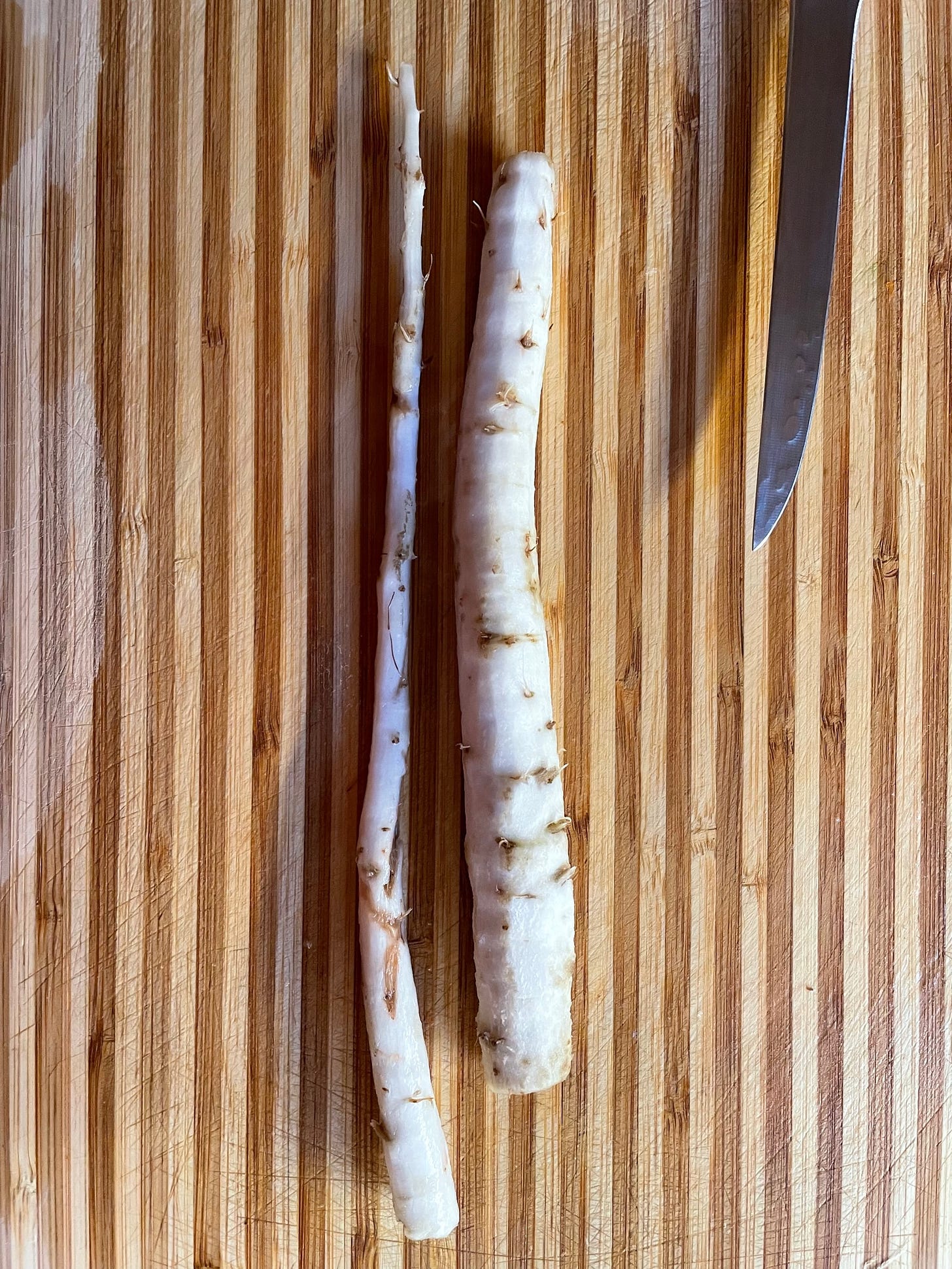
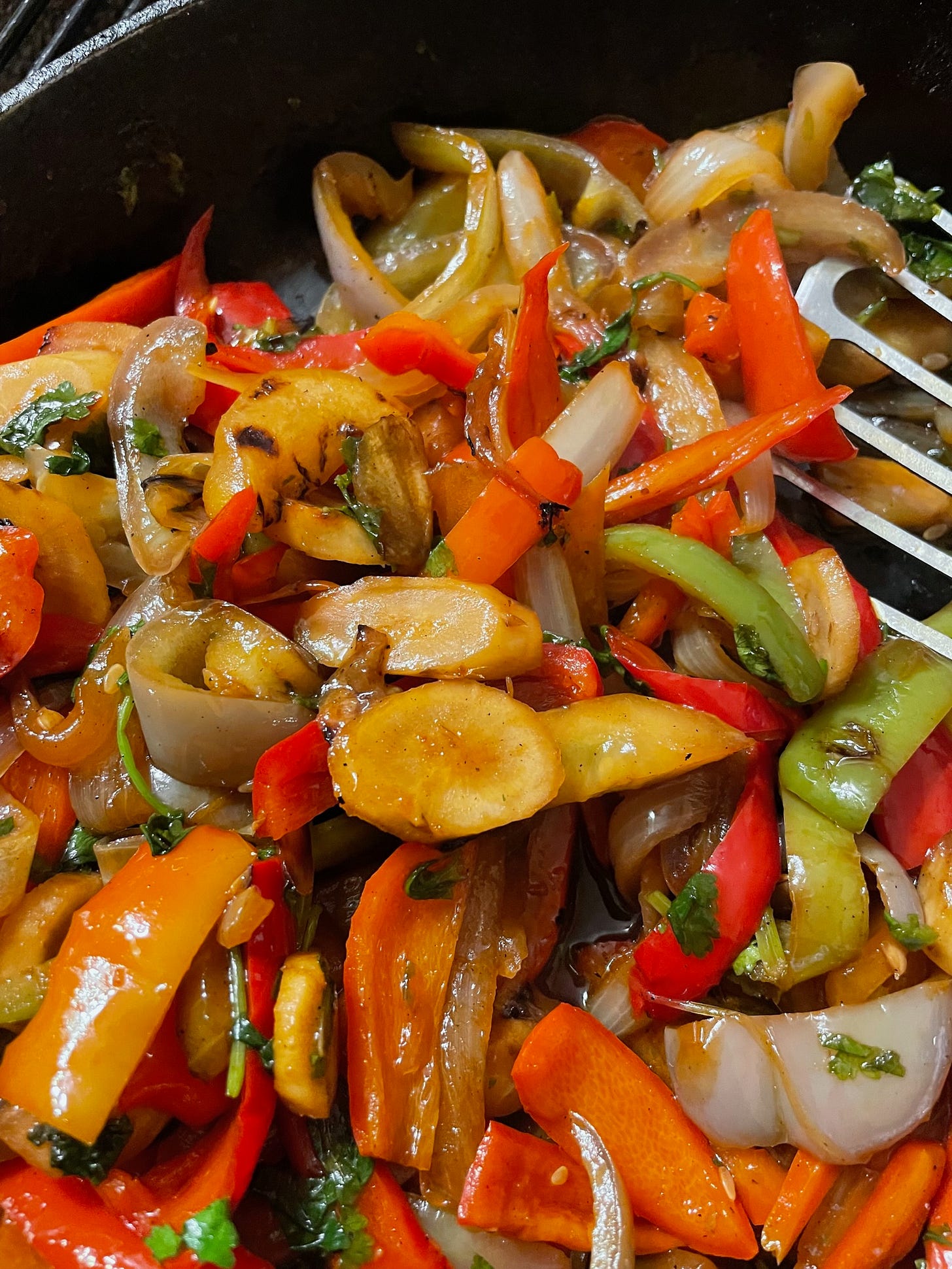


So would it be beneficial to combine Chicory & Burdock together in a tea for instance or would that be added too much inulin? I have a recipe that I’m using as a alternative for coffee but I believe (if memory is correct)I’m only including the chicory root. There are other ingredients as well but only one source providing the inulin.